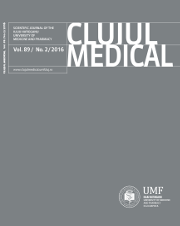The Role of the Diffusion Sequence in Magnetic Resonance Imaging for the Differential Diagnosis between Hepatocellular Carcinoma and Benign Liver Lesions
DOI:
https://doi.org/10.15386/cjmed-567Keywords:
focal liver lesions, hepatocellular carcinoma, magnetic resonance imaging, diffusion weighted imaging, differential diagnosisAbstract
Background and aim. To assess the role of diffusion weighted imaging sequence (DWI), routinely used in hepatic magnetic resonance imaging (MRI) for the differentiation of hepatocellular carcinoma (HCC) from benign liver lesions.
Methods. A number of 56 liver MRI examinations were retrospectively analyzed independently by two experienced radiologists, blinded to each other results. A total number of 70 Focal Liver Lesions (FLLs) assessed by liver MRI in 56 patients were included in the present study. All lesions were retrospectively analyzed by two experienced radiologists, independently from each other and who were not aware of the previous results given by using different imaging techniques. All included FLLs had a final histological diagnosis, or the final diagnosis was based on consensus reading by two experienced radiologists. The signal of the included FLLs was qualitatively appreciated on the b-800 sequences and on the apparent diffusion coefficient (ADC) map. The ADC value of each FLL was measured and the ADC ratio between the ADC value of the assessed FLL and that of the surrounding liver parenchyma was calculated.
Results. The mean ADC value for benign FLLs as assessed by the two independent readers was 1.75 x 10¯³and 1.72 x 10¯³. The mean ADC value for HCC nodules was 0.92 x 10¯³ for the first reader and 0.91 x 10¯³ for the second reader respectively. The mean ADC ratio for benign FLLs was 1.81 and 1.84 for the two readers, respectively. The ADC ratio for HCC nodules was 0.91 and 0.91, respectively. The ADC value is an indicator which is less prone to interobserver variability (correlation of 0.919→1). The ADC ratio has, as the analysis of the ROC curve shows, the best predictive value for differentiation between benign FLLs and HCC nodules. Analysis of the signal intensity on the DWI b-800 image alone is of no significance in differentiating benign FLLs from HCC nodules (p>0.005).
Conclusions. The ADC value and the ADC ratio assessed on liver DWI are useful diagnostic tools in the differential diagnosis of benign FLLs vs HCC nodules. Quantitative methods such as calculating the ADC value or ADC ratio have better diagnostic value than qualitative techniques.
Downloads
Additional Files
Published
How to Cite
Issue
Section
License
The authors are required to transfer the copyright of the published paper to the journal. This is done by agreeing to sign the Copyright Assignment Form. Whenever the case, authors are also required to send permissions to reproduce material (such as illustrations) from the copyright holder.

The papers published in the journal are licensed under a Creative Commons Attribution-NonCommercial-NoDerivatives 4.0 International License.

